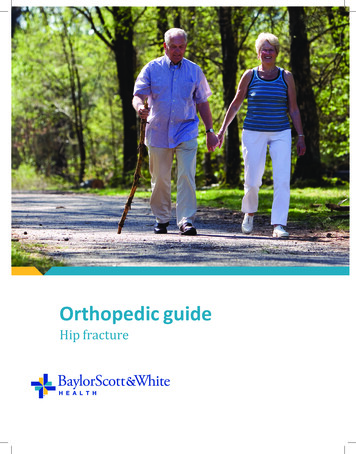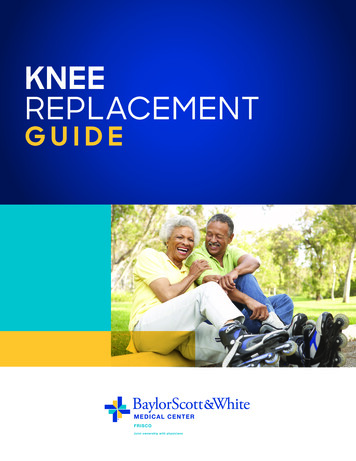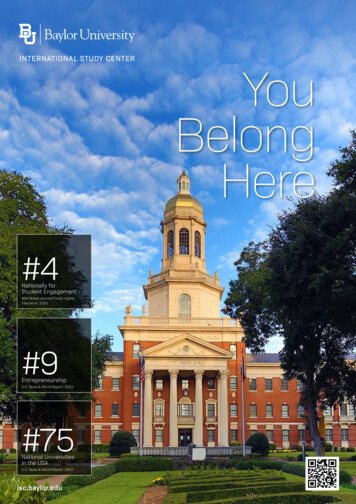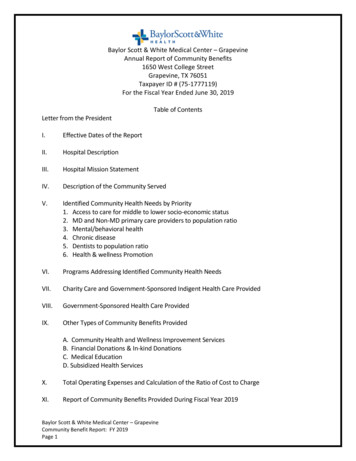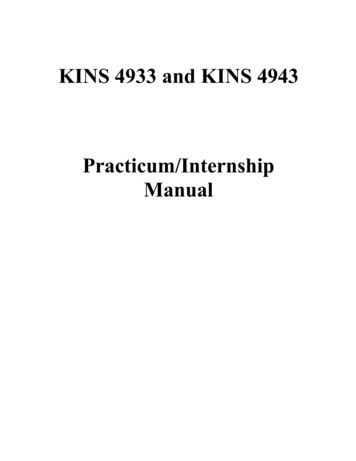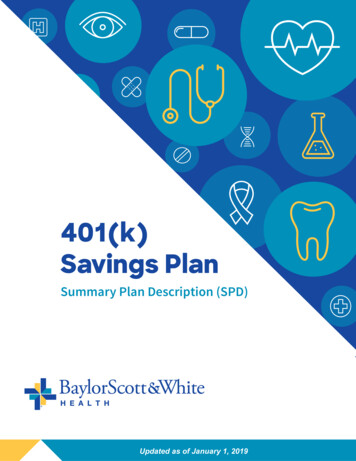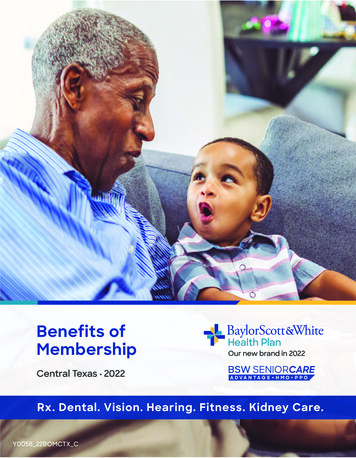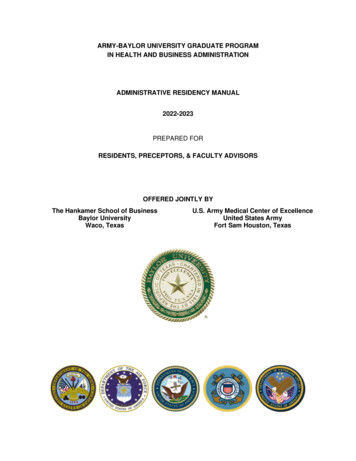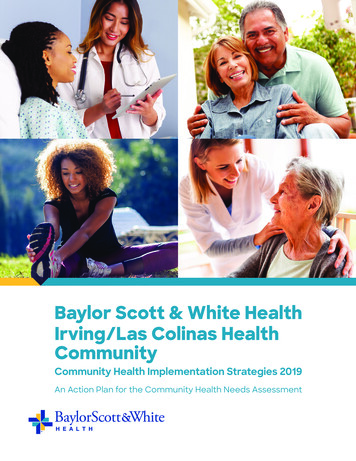
Transcription
Baylor Scott & White HealthIrving/Las Colinas HealthCommunityCommunity Health Implementation Strategies 2019An Action Plan for the Community Health Needs Assessment
Irving/Las ColinasHealth CommunityHospitals Baylor Scott & White Medical Center — Irving Baylor Surgical Hospital at Las ColinasApproved by: Baylor Scott & White Health — North Texas Operating, Policy and Procedure Board Oct. 29, 2019Posted to BSWHealth.com/CommunityNeeds Nov. 15, 2019
Table of ContentsExecutive Summary2A Letter from the Presidents4Irving/Las Colinas Community Health Implementation Strategies5Irving/Las Colinas Health Community Needs7Implementation Strategies Addressing:8Food InsecurityPercentage of Population Under Age 65 Without Health Insurance810Community Needs Not Addressed13Composite 2018 Community Need Index14Program Evaluation15Irving/Las Colinas Health Community1
Executive SummaryAs the largest not-for-profit healthcare system in Texas, Baylor Scott & White Health(BSWH) understands the importance of serving the health needs of its communities.In order to do that successfully, the System is constantly surveying patients, theirfamilies and neighbors to understand the issues they face when it comes to makinghealthy life choices and healthcare decisions.Earlier in 2019, a BSWH task force led by the community benefit, tax compliance andcorporate marketing departments began assessing the current health needs of allthe communities served bySystem hospitals. IBM WatsonHealth (formerly known asTruven Health Analytics)analyzed the data for thisprocess and prepared a finalreport made publicly availablein June 2019.For the 2019 assessment, thecollaborating BSWH hospitalfacilities served Dallas andTarrant counties. At least75% of the hospital facilities’admitted patients live in thisgeographic area.BSWH and IBM Watson Healthexamined more than 102public health indicators andconducted a benchmarkanalysis of this data, comparing the community to overall state of Texas and U.S.values. Community focus groups, including a representation of minority, underservedand indigent populations provided input for a qualitative analysis. Group Interviewswith key community leaders and public health experts provided depth and contextto the report.Any community needs that did not meet state benchmarks were included in amagnitude analysis index. Understanding the degree of difference from benchmarkIrving/Las Colinas Health Community2
helped determine the relative severity of the issue. The outcomes of this quantitativeanalysis were aligned with the qualitative findings of the community input sessionsto elicit a list of health needs in the community. These health needs fell into one offour quadrants within a health needs matrix: high data/low qualitative; low data/lowqualitative; low data/high qualitative; or high data/high qualitative.A community focus group, including a representationof minority, underserved and indigent populations,provided input for a qualitative analysis.Hospital and clinic leadership, along with community leaders, reviewed the matrix ina session that established a list of significant prioritized needs. The session includedan overview of the community demographics, a summary of health data findings andan explanation of the quadrants of the health needs matrix.Those health needs falling into the “high data/high qualitative” quadrant wereconsidered the most significant and in need of the most attention. Each sessionattendee identified and prioritized five needs. The most significant health needsemerged from this process.Irving/Las Colinas Health Community3
Dear Community Members:Baylor Scott & White is committed to improving health in the communities we serve.As part of that commitment, every three years we conduct a Community HealthNeeds Assessment (CHNA) and report on our community’s current health needs. Wealso provide the Community Health Implementation Strategies report, which is ourplan for addressing the identified needs.We are pleased to present the 2019 Implementation Strategies for Irving/LasColinas Health Community, a companion piece to the CHNA that provides plans foraddressing our most pressing health needs. The CHNA for the health communityhospital facilities incorporates input from influencers such as key stakeholders, arearesidents, faith-based organizations, healthcare providers, neighborhood associationleaders, elected officials, health professionals, hospital and System leaders, themedically underserved and others.The Implementation Strategies address the most severe health concerns thatnegatively impact community health. Hospital leadership selected the followingpriorities to focus on in the Strategies: Food Insecurity Percentage of Population Under Age 65 Without Health InsuranceThe full report can be found at http://BSWHealth.com/CommunityNeeds.As part of the largest not-for-profit health system in Texas, we take our commitmentto Irving/Las Colinas Health Community very seriously. By working with communityorganizations and residents, we have identified and will focus on some of thetoughest problems plaguing our most vulnerable residents.Sincerely,Baylor Scott & White Facility PresidentsIrving/Las Colinas Health CommunityIrving/Las Colinas Health Community4
Irving/Las ColinasCommunity Health Implementation StrategiesThe Community Health Implementation Strategies for Irving/Las Colinas HealthCommunity is the companion piece to the CHNA. Public and hospital data and inputgleaned from stakeholders representing the broad interests of the community are thefoundation for this report, which offers realistic solutions to the community’s priorityhealth needs (see CHNA Reportwww.BSWHealth.com/CommunityNeeds).The community served by the collaboratingThe focus group recommended using theBSWH hospital facilities includes Dallas andfollowing prioritization criteria to rank theTarrant counties and includes themost significant health needs:geographic area where at least 75% of the1hospital facilities’ admitted patients live.This written plan satisfies the requirementsRoot Cause: the need is a root cause ofset forth in Internal Revenue Code (IRC)other problems, thereby addressing itSection 501(r) (3) and the Texas Health andcould possibly impact multiple issuesSafety Code Chapter 311 and is widely2available to the public.The overall purpose of the ImplementationStrategies is to align the hospitals’charitable mission, program services andlimited resources with the findings of theCHNA. To meet the requirements underIRC Section 501(r) (3), the writtenImplementation Strategy includes thefollowing: List of the prioritized needs the hospital Vulnerable Populations: there is a highneed among vulnerable populations and/or vulnerable populations are adverselyimpacted3Community Capacity: the community hasthe capacity to act on the issue, includingany economic, social, cultural or politicalconsideration4plans to address and the rationale for notCommunity Strength: extent thataddressing other significant health needsinitiatives to address the issue can buildidentifiedon existing community strengths andActions the hospital intends to take toresourcesaddress the chosen health needsThe anticipated impact of these actionsand the plan to evaluate such impact(e.g., identify data sources that will be used to track the plan’s impact)Irving/Las Colinas Health Community5
Identify programs and resources the hospital plans to commit to address thehealth needs Describe any planned collaboration between the hospital and other facilities ororganizations in addressing the health needsIrving/Las Colinas Health Community6
Irving/Las Colinas Health Community NeedsThe following health concerns are identified in priority order based on the results ofthe CHNA.PriorityNeedCategory of Need1Food InsecurityEnvironment – food2Individuals Living Below Poverty LevelSDH* – Income3Percentage of Population Under Age 65 Without HealthInsuranceAccess to Care4No Vehicle AvailableAccess to Care5Severe Housing ProblemsEnvironment – Housing*SDH — Social Determinant of HealthThe hospital facilities listed below collaborated to conduct this joint implementationstrategy and have reviewed the significant health needs identified above. Hospitalleadership selected the following health needs as the most important to confront incollaboration with the community based on the anticipated impact to the community,hospital resources available, and the expertise of each respective hospital facility.COMMUNITY NEEDS ADDRESSEDFacilityFoodInsecurityPercentage of Population Under Age 65Without Health InsuranceBaylor Scott & White MedicalCenter — IrvingBaylor Surgical Hospital at LasColinasIrving/Las Colinas Health Community7
Implementation StrategiesPriority 1: Food Insecurity — Food insecurity is a measurement of the prevalenceof hunger in the community; it reflects the percentage of the population who didnot have access to a reliable source of food. Lacking consistent access to food isrelated to negative health outcomes such as weight- gain and premature mortality.Individuals and families with an inability to provide and eat balanced meals createadditional barriers to healthy eating.It is equally important to eat a balanced diet that includes fruits and vegetables aswell as to have adequate access to a consistent supply of food. In Tarrant County17.4% of the population lacked adequate access to food within the preceding year.This value was 11% higher than the state benchmark and may indicate a greater needor vulnerability within the population. The U.S. benchmark is 13%, this was lower thanthe state of Texas as well as Denton and Tarrant counties.BAYLOR SCOTT & WHITE MEDICAL CENTER — IRVINGAction/TacticsAnticipatedImpactHospital ResourcesContributedOutcomes toMeasure(Programs, Staff, Budget)Community OrganizationCollaborators(if applicable)Cash and in-kindcontributions toother not-forprofit communityorganizationsexisting toincrease accessto care for thecommunityIncreased accessto healthy foodfor underservedpopulationsCommunitySupport FundPersons servedHealthoutcomesHeritage Senior Centerdaily meal programIrving CaresVNA Meals on WheelsNutritioneducationprogramsIncreasedawareness ofchronic conditionsManagementand locations ofavailable foodsources (diabetes,CHF)StaffBudgetNumber ofpersons servedNumber ofreferrals madeto food sourcesIrving Community ClinicHeritage Senior CenterIrving ISDDisseminateand updatecommunityresource guideIncreasedawareness offood distribution/access communityresourcesIrving CommunityBenefit team andCare CoordinationNumberof guidesdistributedIrving/Las Colinas Health Community8
Priority 1: Food InsecurityAction/TacticsAnticipatedImpactHospital ResourcesContributedOutcomes toMeasure(Programs, Staff, Budget)Collaboration withlocal farmer’smarketsIncreased accessto healthy foodfor underservedpopulationsCare CoordinationCommunity OrganizationCollaborators(if applicable)Persons servedCost of serviceprovisionHealthoutcomesFarmer’s Market vendorsBAYLOR SURGICAL HOSPITAL AT LAS COLINASAction/TacticsAnticipatedImpactHospital ResourcesContributedOutcomes toMeasure(Programs, Staff, Budget)Community OrganizationCollaborators(if applicable)Cash and in-kindcontributions toother not-forprofit communityorganizationsexisting toincrease accessto care for thecommunityIncreased accessto healthy foodfor underservedpopulationsCommunitySupport FundPersons servedHealthoutcomesFamily Promise of IrvingFood driveIncreased accessto healthy foodfor mount of fooddonatedCrisis MinistriesIrving/Las Colinas Health Community9
Priority 3: Percentage of Population Under Age 65 Without Health Insurance — Lack ofhealth insurance is a significant barrier in accessing healthcare and overall financialsecurity. A key finding from a recent Kaiser Foundation paper included; “Goingwithout coverage can have serious health consequences for the uninsured becausethey receive less preventative care, and delayed care often results in seriousillness or other health problems. Being uninsured can also have serious financialconsequences, with many unable to pay their medical bills, resulting in medicaldebt.”According to the 2018 County Health Rankings, the rate of uninsured populationunder age 65 across Texas is 19.2%, compared to an overall U.S. rate of 11% and topperforming U.S. counties rate of 6%. The Irving/Las Colinas Health Community iscomprised primarily of Dallas County and had an uninsured rate for the populationunder age 65 of 22.6%, higher than the overall Texas rate by 18%. The proportionof uninsured in Dallas County points to potential need and a larger vulnerablepopulation for the greater Irving/Las Colinas Health Community.Irving/Las Colinas Health Community10
Priority 3: Percentage of Population Under Age 65 Without Health InsuranceBAYLOR SCOTT & WHITE MEDICAL CENTER — IRVINGAction/TacticsAnticipatedImpactHospital ResourcesContributedOutcomes toMeasure(Programs, Staff, Budget)(if applicable)Community CareClinics provide amedical home forpatients needingcomprehensiveprimary careservices, chronicdisease educationand management,and communitybased carecoordinationIncreasedaccess to carefor uninsuredpopulation underage 65BudgetStaffSuppliesOverheadNumber ofpatients servedProvide free and/or discountedcare to financiallyor medicallyindigent patientsas outlined inthe financialassistance policyIncreased accessto primarycare and/orspecialty care forindigent personsregardless of theirability to payHealthcareinfrastructureSuppliesStaffNumberof personsreceivingassistanceUnreimbursedcost of careHelp allpopulations reachoptimal healthby integratingfaith communitieswith healthcareto increaseeffective patientnavigation,education andsupport tocreate healthiercommunitiesIncreasedaccess to carefor uninsuredpopulation underage 65Faith CommunityHealth Dept.Volunteer TrainingNumber ofcommunitypartnersdevelopedNumber oftraining classesofferedNumber ofpersons servedIrving/Las Colinas Health CommunityCommunity OrganizationCollaboratorsIrving Interfaith ClinicFaith Community Partners11
Priority 3: Percentage of Population Under Age 65 Without Health InsuranceAction/TacticsAnticipatedImpactHospital ResourcesContributedOutcomes toMeasure(Programs, Staff, Budget)To help addressthe State’s healthcare workforceshortage BSWHprovides a clinicaltraining programto preparephysiciansand nurses forthe medicalworkforceIncreasedavailability ofhealthcareproviders ina medicallyunderserved areaNurse/PhysicianEducatorsStudent supervisorystaffBudgetCommunity OrganizationCollaborators(if applicable)Number ofstudents trainedNumber ofspecialtiesTotal numberof studentstrainedArea colleges & universitiesBAYLOR SURGICAL HOSPITAL AT LAS COLINASAction/TacticsAnticipatedImpactHospital ResourcesContributedOutcomes toMeasure(Programs, Staff, Budget)Provide free and/or discountedcare to financiallyor medicallyindigent patientsas outlined inthe financialassistance policyIncreased accessto primarycare and/orspecialty care forindigent personsregardless of theirability to payIrving/Las Colinas Health unity OrganizationCollaborators(if applicable)Numberof personsreceivingassistanceUnreimbursedcost of care12
Community Needs Not AddressedBSWH provides a wide range of needed healthcare services and community benefitsthrough adherence to its mission, using its resources and capabilities and remaininga strong organization. By focusing on our strengths and allocating our resourcesappropriately, we can achieve a greater impact in the communities we serve.Needs not addressed: Ratio of Population to One Dentist No Vehicle Available Severe Housing ProblemsThere are multiple community and state agencies whose expertise and infrastructureare better suited for meeting the needs not addressed in the Community HealthImplementation Strategies. Therefore, BSWH leadership has opted to focus itsresources on the listed priorities for the betterment of the community.Irving/Las Colinas Health Community13
Composite 2018 Community Need IndexThe Community Need Index shows the high-need areas in Irving/Las Colinas HealthCommunity in contrast to the state of Texas and the U.S.Composite 2018 Community Need Index: high scores indicate high need.0.05.0State and NationalComposite CNI Scores3.9ZIP Map where color shows the CommunityNeed Index on a scale of 0 to 5. Orange colorindicates high need areas (CNI 4 or 5);blue color indicates low need (CNI 1 or 2).Gray colors have needs at the nationalaverage (CNI 3).3.0NTX Irving/Las ColinasComposite CNI Score4.1IBM Watson Health created this CNI, which is a statistical approach to identifyingareas within a community where health disparities may exist. The CNI takes intoaccount vital socio-economic factors (income, cultural, education, insurance andhousing) about a community to generate a CNI score for every populated ZIP codein the United States. The CNI strongly linked to variations in community healthcareneeds and an indicator of a community’s demand for various healthcare services.The CNI score by ZIP code identifies specific areas within a community wherehealthcare needs may be greater.Irving/Las Colinas Health Community14
Program EvaluationAll community benefit activities align with community benefit goals by adheringto BSWH’s policies and procedures. This ensures appropriate governance of theactivities outlined in these Community Health Implementation Strategies. Thehospitals evaluate programs and activities on a regular basis to ensure appropriateuse of staff time and hospital resources.To support the hospital’s community benefit objectives, requests for contributionsfrom other unrelated 501(c) (3) charitable organizations managed by the CommunityBenefit Department are considered alongside those activities addressing a priorityneed in the community given preference. All charitable giving is reviewed andapproved annually by hospital leadership and the BSWH governing board.BSWH regularly assesses, evaluates and reports on the programs addressing thesignificant needs found in identified communities. Regular conversations withcommunity members, feedback on this plan and modifying programs and servicesenhance the opportunities patients have to connect to community resources. As aresult, these hospital facilities achieve reduction in unnecessary healthcare costs andimproved delivery of overall quality of care.Please direct any feedback on the assessment or implementation plan toCommunityHealth@BSWHealth.org.This document may be accessed at http://BSWHealth.com/CommunityNeeds.Photography may include models or actors and may not represent actual patients. 2019 Baylor Scott & White Health.Irving/Las Colinas Health Community15
SDH* - Income Access to Care Access to Care Environment - Housing *SDH — Social Determinant of Health Irving/Las Colinas Health Community Baylor Scott & White Medical Center — Irving Baylor Surgical Hospital at Las Colinas Facility Food Insecurity Percentage of Population Under Age 65 Without Health Insurance COMMUNITY NEEDS ADDRESSED
